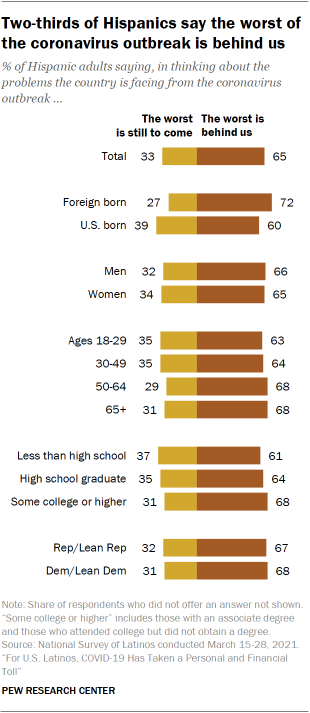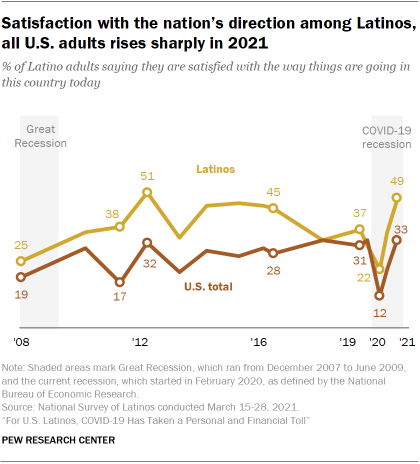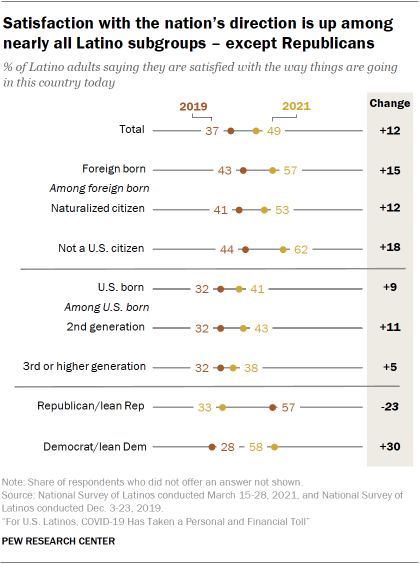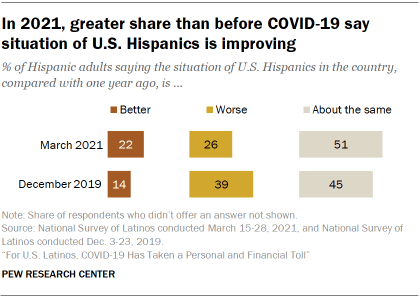The COVID-19 pandemic hit Hispanics hard economically and took a substantial toll on the physical and mental health of the population. Yet most now say the worst of COVID-19’s effects are behind us. And their views about and the country’s direction and the situation of Hispanics in the country have improved markedly since December 2019, before the coronavirus outbreak impacted the United States.
Hispanic views about the pandemic’s impact on the country have flipped from negative to positive over the course of several months. In March 2021, two-thirds (65%) of Hispanics said the worst of the problems facing the nation from the coronavirus outbreak are behind us, while for 33%, the worst is still to come. This is a reversal from April 2020, when a Pew Research Center survey found 23% of Hispanics said the worst was behind the country while 75% said the worst was still to come.
Immigrants are more likely than the U.S. born to say the worst of the coronavirus pandemic for the country has passed. Some 72% of immigrant Latinos say this, compared with 60% of U.S.-born Latinos. Meanwhile, majorities of all major Latino subgroups say the worst of the pandemic has passed.
A growing share of Latinos are satisfied with the nation’s direction
Before the coronavirus outbreak hit the United States in February 2020, Latinos were largely dissatisfied with the nation’s direction. In December 2019, 62% said so while 37% said they were satisfied.
Latinos’ assessments of the country’s direction worsened through 2020 during the pandemic. The share satisfied with the country’s direction reached lows of only 22% in August and 23% in October 2020. Since then, Latinos’ views on the nation’s direction have grown more positive, reaching 49% in March 2021. This share is up 12 percentage points since December 2019 and has reached its highest level since 2012, when 51% of Latino adults said they were satisfied with the nation’s direction. It is among the highest levels of satisfaction since 2008.
The increasingly positive views about the nation’s direction extend across nearly every major demographic subgroup of Hispanics, with some of the biggest gains among immigrants. Overall, 57% of immigrant Latinos say they are satisfied with the nation’s direction in March 2021, up from 43% in December 2019. Among immigrant Latinos who do not hold U.S. citizenship, 62% say they are satisfied with the nation’s direction, up from 44% in 2019.
Positive assessments of the national direction are up among U.S.-born Hispanics as well, though not as sharply. About 41% in March 2021 say they are satisfied with the country’s direction, up from 32% in December 2019, or 9 percentage points. Similar shares of second-generation Hispanics and third- or higher-generation Hispanics say they are satisfied with the nation’s direction (43% and 38%), and both are up since 2019.
Views of the national direction have shifted sharply among Hispanic partisans. In March 2021, 58% of Hispanics who identify with or lean toward the Democratic Party say they are satisfied with the country’s direction, up 30 points since December 2019, when 28% said the same. By contrast, assessments among Republican and GOP-leaning Hispanics are down. In March, one-third said they were satisfied with the country’s direction, down 24 points since December 2019, when 57% said they were satisfied.
There are other notable patterns among Latino demographic subgroups. For example, assessments are up sharply among Latinos with less than a high school education and Latino high school graduates, but unchanged for those with some college education. In March, 57% of Latinos with less than a high school education and 52% of Latino high school graduates are satisfied with the nation’s direction, up from 37% and 34% in December 2019. Meantime, 43% of those with some college experience or more say they are satisfied, about the same share (40%) as in 2019. And among those ages 18 to 29, about half (49%) say they are satisfied with the direction of the country, up from 35% in December 2019. By contrast, about half (47%) of Latinos ages 65 and older say they are satisfied with the nation’s direction as of March, up somewhat from 42% in December 2019.
Growing share of Hispanics see improvement in group’s situation over the last year, but about half see little change
About half (51%) of Hispanic adults say the situation of U.S. Hispanics is about the same compared with one year ago, while 26% say things have worsened and 22% say the situation for their group has improved over the period, according to the March 2021 survey. This is a marked improvement compared with December 2019, then three years into the Trump administration and before the start of the coronavirus pandemic in the U.S. and the 2020 presidential election. At that time, 45% of Hispanic adults said the situation of U.S. Hispanics was about the same compared with the year before, 39% said things had worsened over the same period and just 14% said things had improved for their group.
The improved assessment of U.S. Latinos’ situation is a view shared across nearly all groups of Latinos, with one of the sharpest shifts coming among immigrant Latinos who do not hold U.S. citizenship. Among this group, 30% say the situation of U.S. Latinos in the country is better than a year ago, up from 11% who said the same in 2019. Meanwhile, the share saying the situation of U.S. Latinos has worsened in the last year is down, to 21% in 2021 from 39% in 2019.
Overall, 27% of immigrant Latinos say the situation of U.S. Latinos in the country is improved, higher than the share (15%) who said the same in 2019. And 47% say it is about the same, compared with a year ago, unchanged from 2019. One-quarter (25%) of immigrant Latinos say the situation of U.S. Latinos is worse than a year ago, down from 37% who said this in December 2019.
Among U.S.-born Hispanics, assessments of the group’s situation are also improved, but in a different way from immigrant Hispanics. Just like their foreign-born counterparts, a smaller share of U.S.-born Hispanics say the situation of the group in the country has worsened in the last year – 26% hold this view in 2021, down from 42% in 2019. At the same time, the share saying the situation of U.S. Hispanics is about the same as a year ago rose to 55% in 2021 from 44% in 2019, an increase of 11 percentage points. Meanwhile, 17% of U.S.-born Hispanics say the situation of Hispanics in the country is better today; in 2019, 13% said the same. Similar changes in views occurred among second-generation and third- or higher-generation Hispanics, with the biggest change among those who say the situation of U.S. Hispanics is about the same as a year ago.
Assessments of how U.S. Latinos are doing in the country today compared with one year ago shifted sharply for Latino Democrats but changed less for Latino Republicans. Among Latinos who identify with or lean toward the Democratic Party, the share saying the situation of U.S. Latinos had worsened in the last year fell from 47% in December 2019 to 25% in March 2021, a 22-point decline. And the share of Democrats saying U.S. Latinos’ situation is better roughly doubled, rising from 9% to 24% over the same period. About the same share of Latino Republicans in December 2019 and March 2021 said the situation for U.S. Latinos had worsened in the last year – 26% and 30% respectively. And positive assessments among Latino Republicans were down over the period: 27% in December 2019 said U.S. Latinos’ situation had improved in the last year, while 18% said this in March 2021.







